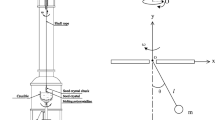Abstract
Chaos occurs in the flexible shaft rotating-lifting (FSRL) system of crystal growth process. Chaotic swing does harm to the quality of mono-silicon crystal production. Therefore, it must be suppressed. Previous studies have proposed impulse control method to suppress the chaos in crystal growth process. However, the impulses require sudden and intermittent changes to the rotation speed, which are difficult to implement through the soft rope connection. In this work, a small amplitude resonant perturbation to the rotation speed is being proposed to suppress chaos in the FSRL system. The system state, given by the swing angle between the rotation center on the vertical axis and the soft shaft, is observed by measuring the force on the soft shaft and by using the untraced Kalman filter. The control parameters are selected by calculating the Lyapunov exponent. As compared with the previous impulse control methods, the proposed small amplitude resonant perturbation method engenders a small continuous change instead of the sudden change in the rotation speed. In addition, the proposed method does not alter the average rotation speed, which complies with the crystal growth technique requirement. The effectiveness of the proposed chaos control method is validated by numerical simulations.
















Similar content being viewed by others
Data Availability Statement
All data generated or analyzed during this study are included within the article.
References
Ren, H.P., Zhou, Z.X., Grebogi, C.: Nonlinear dynamics in the flexible shaft rotating lifting system of silicon crystal puller using Czochralski method. Nonlinear Dyn. 102, 771–784 (2020)
Ott, E., Grebogi, C., Yorke, J.A.: Controlling chaos. Phys. Rev. Lett. 64(11), 1196–1199 (1990)
Yang, T., Yang, L.B., Yang, C.M.: Impulsive control of Lorenz system. Phys. D. 110(1–2), 18–24 (1997)
Lima, R., Pettini, M.: Suppression of chaos by resonant parametric perturbations. Phys. Rev. A 41(2), 726–733 (1990)
Zhou, Z.X., Grebogi, C., Ren, H.P.: Parameter impulse control of chaos in crystal growth process. J. Cryst. Growth. 563, 126079 (2021)
Zhou, Z.X., Ren, H.P., Grebogi, C.: Bi-directional impulse chaos control in crystal growth. Chaos 31, 53106 (2021)
Fronzoni, L., Giocondo, M., Pettini, M.: Experimental evidence of suppression of chaos by resonant parametric perturbations. Phys. Rev. A 43(12), 6483–6487 (1991)
Lima, R., Pettini, M.: Parametric resonant control of chaos. Int. J. Bifurc. Chaos. 8(8), 1675–1684 (1998)
Inaba, N., Sekikawa, M., Endo, T., Takashi, T.: Revealing the trick of taming chaos by weak harmonic perturbations. Int. J. Bifurc. Chaos. 13(10), 2905–2915 (2003)
Zhou, Y.F., Tse, C.K., Qiu, S.S., Chen, J.N.: An improved resonant parametric perturbation for chaos control with applications to control of DC/DC converters. Chin. Phys. B 14(1), 61–66 (2005)
Yang, J.P., Jing, Z.J.: Inhibition of chaos in a pendulum equation. Chaos. Soliton. Fract. 35(4), 726–737 (2008)
Yang, J.P., Jing, Z.J.: Control of chaos in a three-well duffing system. Chaos. Soliton. Fract. 41(3), 1311–1328 (2009)
Tamura, T., Inaba, N., Miyamichi, J.: Mechanism for taming chaos by weak harmonic perturbations. Phys. Rev. Lett. 89(19), 3824–3827 (1999)
Chacón, R., García-Hoz, A.M., Miralles, J.J., Martínez, P.J.: Amplitude modulation control of escape from a potential well. Phys. Lett. A. 378, 1104–1112 (2014)
Qu, Z.L., Hu, G., Yang, G.J., Qin, G.R.: Phase effect in taming non-autonomous chaos by weak harmonic perturbations. Phys. Rev. Lett. 74(10), 1736–1739 (1995)
Chacón, R.: Role of ultrasubharmonic resonances in taming chaos by weak harmonic perturbations. Eurphys. Lett. 54(2), 148–153 (2001)
Wu, G., Li, L.S., Cong, X.R.: Chaos control for coupling of the double-well duffing system based on random phase disturbance. Int. J. Theor. Phys. 52, 1956–1963 (2013)
Zambrano, S., Allaria, E., Brugioni, S., Leyva, I., Meucci, R., Sanjuán, M.A., Arecchi, F.T.: Phase control of intermittency in dynamical systems. Phys. Rev. E 74(1), 016202 (2006)
Zambrano, S., Allaria, E., Brugioni, S., et al.: Numerical and experimental exploration of phase control of chaos. Chaos 16, 013111 (2006)
Amer, Y.A., Bauomy, H.S., Sayed, M.: Vibration suppression in a twin-tail system to parametric and external excitations. Comput. Math. Appl. 58(10), 1947–1964 (2009)
Li, L.S., Yu, H.D.: Chaos control of a class of parametrically excited Duffing’s system using a random phase. Chaos. Soliton. Fract. 44(7), 498–500 (2011)
Chen, X.W., Jing, Z.J., Fu, X.G.: Chaos control in a pendulum system with excitations and phase shift. Nonlinear Dyn. 78(1), 317–327 (2014)
Chacón, R., Martínez, J.A.: Controlling escape from a potential well by reshaping periodic secondary excitations. Phys. Rev. E 83(1), 016201 (2011)
Chacón, R., Martínez, J.A., Miralles, J.J.: Impulse-induced optimum control of escape from a metastable state by periodic secondary excitations. Phys. Rev. E 85(6 Pt 2), 066207 (2012)
Ren, H.P., Bai, C., Tian, K., Grebogi, C.: Dynamics of delay induced composite multi-scroll attractor and its application in encryption. Int. J. Nonlin. Mech. 94, 334–342 (2017)
Funding
This work was supported in part by the Shaanxi Provincial Special Support Program for Science and Technology Innovation Leader.
Author information
Authors and Affiliations
Corresponding author
Ethics declarations
Conflict of interest
The authors declare that they have no conflict of interest.
Additional information
Publisher's Note
Springer Nature remains neutral with regard to jurisdictional claims in published maps and institutional affiliations.
Appendix
Appendix
Some function definitions are given in the following. For the elliptic integrals function of the first kind,
its inverse function is written by:
Then, Jacobian elliptic functions \(sn(\cdot )\) and \(dn(\cdot )\) are defined by:
The complete elliptic integral of the first kind is given by,
Rights and permissions
About this article
Cite this article
Zhou, ZX., Ren, HP. & Grebogi, C. Suppressing chaos in crystal growth process using adaptive phase resonant perturbation. Nonlinear Dyn 108, 2655–2669 (2022). https://doi.org/10.1007/s11071-022-07333-6
Received:
Accepted:
Published:
Issue Date:
DOI: https://doi.org/10.1007/s11071-022-07333-6




